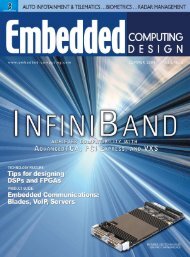CompactPCI and AdvancedTCA Systems - OpenSystems Media
CompactPCI and AdvancedTCA Systems - OpenSystems Media
CompactPCI and AdvancedTCA Systems - OpenSystems Media
You also want an ePaper? Increase the reach of your titles
YUMPU automatically turns print PDFs into web optimized ePapers that Google loves.
T E C H N O L O G Y<br />
I N T E R N E T M O D E M S<br />
become very competitive, so the user must estimate traditional<br />
modem usage traffic <strong>and</strong> compare that cost to the sum of the fixed<br />
ISP cost per element.<br />
Point-to-point versus multipoint<br />
St<strong>and</strong>ard modems are point-to-point communication elements.<br />
A source element contacts one destination element <strong>and</strong> communication<br />
ensues until a termination occurs. This provides for<br />
maximum security <strong>and</strong> real-time data transfer. With traditional<br />
networks that have a central host, the central host can concentrate<br />
<strong>and</strong> distribute the data where appropriate. With the exception of<br />
the socket-to-socket transfer mentioned earlier, iModem transfer<br />
can be multipoint. With the iModem each message can be sent to<br />
multiple web pages or multiple recipients via their unique e-mail<br />
addresses in one transaction. E-mail distributes its own messages<br />
through the multiple recipients addressing structure to other<br />
e-mail enabled machines or st<strong>and</strong>ard Internet enabled PCs. Each<br />
iModem can host its own web page or can route information to<br />
multiple web pages.<br />
With the advent of ISPs dedicated to machine-to-machine communications,<br />
it is possible to send an ASCII e-mail message <strong>and</strong> have<br />
it converted by the ISP to fax or a natural sounding voice message.<br />
The central host performs this role in traditional networks.<br />
Message storage requirements<br />
Traditional modems perform data transactions without storage in<br />
the modem or a record of a given transaction. All messages are<br />
sent transparently. If message storage or cataloging is required it<br />
must be accommodated by the network requirements. For example,<br />
all field messages must be sent to the dedicated central site<br />
host <strong>and</strong> stored in real time. This requires that a central site take in<br />
<strong>and</strong> file the data traffic. With iModems the Internet stores all ISP<br />
messages until requested by the user. In addition, each message is<br />
time stamped as to when it was sent <strong>and</strong> received. All ISPs have<br />
redundancy of storage locations, <strong>and</strong> the ISPs reside in computerfriendly<br />
sites that have emergency backup <strong>and</strong> professional realtime<br />
maintenance.<br />
More intelligence or less<br />
Traditional modems cost less than iModems because they are simpler<br />
<strong>and</strong> have less intelligence. Traditional modems are groomed<br />
to do the very basic modem function. This simplicity of operation<br />
is an inherent feature. With iModems, resident intelligence<br />
is required to do the stack <strong>and</strong> interface to the Internet. This resident<br />
intelligence may be used to enhance the functionality of the<br />
iModem in a user environment. The iModem’s internal processor<br />
may also host user software <strong>and</strong> become the intelligence element<br />
of the user product, or in other words, its processor. It can have<br />
RSC# 2601 @www.compactpci-systems.com/rsc<br />
RSC# 2602 @www.compactpci-systems.com/rsc<br />
26 / <strong>CompactPCI</strong> <strong>and</strong> <strong>AdvancedTCA</strong> <strong>Systems</strong> / September 2005

















